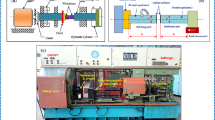Abstract
The fatigue behaviour of the load-carrying fillet welded joints was investigated by experimental and numerical approach in this paper. 26 load-carrying cruciform fillet welded joints involving 8 stress levels were tested and the S-N curves of 95% survival probability in terms of toe failure and root failure were established separately. The testresults also demonstrate that the design curves of Eurocode3 are not suitable for this batch of specimens. In the following numerical simulations, three types of initial crack assumption were analysed by 3D mix-mode fatigue crack propagation analysis according to experimental observation. All the possible crack growth routes were simulated well. However, the single crack assumptions cannot form satisfactory simulations on fatigue lives with enough safety stock. Therefore, multi-crack analysis was conducted based on the combined data in terms of both toe failure and root failure. It is found that multi-crack analysis with 0.5 mm weld toe initial line crack and 0.1 mm weld root initial line crack can provide appropriate prediction. The findings can be beneficial for the fatigue assessment of load-carrying fillet welded joints fabricated by the normal welding technique in China and offer somereferences for the fatigue assessment of structural details with different possible failure modes.
Similar content being viewed by others
References
K.J. Kirkhope, R. Bell, L. Caron, et al., Weld detail fatigue life improvement techniques. Part 1. Review, Marine Structures 12 (6) (1999) 447–474.
S.J. Maddox, Hot-spot stress design curves for fatigue assessment of welded structures, International Journal of Offshore and Polar Engineering 12 (2) (2002) 134–141.
S. Kainuma, T. Mori, A fatigue strength evaluation method for load-carrying fillet welded cruciform joints, International Journal of Fatigue 28 (8) (2006) 864–872.
British Standards Institution (BSI), BS 5400. Steel, Concrete and Composite Bridges - Part 10: Code of Practice for Fatigue, BSI, London, 1980.
European Committee for Standardization (CEN), EN 1993-1-9 Eurocode 3. Design of Steel Structures - Part 1-9: Fatigue, CEN, Brussels, 2005.
American Association of State Highway and Transportation Officials (AASHTO), LRFD Bridge Design Specifications, 3rd ed., AASHTO, Washington, DC, 2004.
F.Z. Akhlaghi, Fatigue Life Assessment of Welded Bridge Details Using Structural Hot Spot Stress Method: A Numerical and Experimental Case Study, (Master’s thesis), Chalmers University of Technology, Göteborg, Sweden, 2009.
A.F. Hobbacher, The new IIWrecommendations for fatigue assessment of welded joints and components - a comprehensive coderecently updated, International Journal of Fatigue 31 (1) (2009) 50–58.
D. Radaj, C.M. Sonsino, W. Fricke, Fatigue Assessment of Welded Joints by Local Approaches, Woodhead Publishing Ltd., Cambridge, 2006.
D. Radaj, Design and Analysis of Fatigue Resistant Welded Structures, Woodhead Publishing Ltd., Cambridge, 1990.
X.W. Ye, Y.H. Su, J.P. Han, A state-of-the-artreview on fatigue life assessment of steel bridges, Mathematical Problems in Engineering 2014 (2014) 1–13.
J.W. Fisher, K.H. Frank, M.A. Hirt, et al., NCHRP Report 102: Effect of Weldments on the Fatigue Strength of Steel Beams, Transportation Research Board, National Research Council, 1970.
L. Zong, G. Shi, Y. Wang, Experimental investigation and numerical simulation on fatigue crack behavior of bridge steel WNQ570 base metal and butt weld, Construction and Building Materials 77 (2015) 419–429.
L. Zong, G. Shi, Y. Wang, Experimental investigation on fatigue crack behavior of bridge steel Q345qD base metal and butt weld, Materials & Design 66 (2015) 196–208.
Z. Barsoum, Residual Stress Analysis and Fatigue Assessment of Welded Steel Structures, (Ph.D. dissertation), Royal Institute of Technology (KTH), Stockholm, Sweden, 2008.
EN B.S. 1090-2, Execution of Steel Structures and Aluminum Structures - Part 2: 2. Technical Requirements for the Execution of Steel Structures, British Standards Institution, London, 2008.
AWS D.1/D1.1M, 2008 Structural Welding Code-Steel, American Welding Society, 2002.
L. Zong, G. Shi, Y.Q. Wang, et al., Fatigue assessment on butt welded splices in plates of different thicknesses, Journal of Constructional Steel Research 129 (2017) 93–100.
L. Zong, G. Shi, Y.Q. Wang, et al., Experimental and numerical investigation on fatigue performance of non-load-carrying fillet welded joints, Journal of Constructional Steel Research 130 (2017) 193–201.
P. Paris, F. Erdogan, A critical analysis of crack propagation laws, Journal of Basic Engineering 85 (4) (1963) 528–534.
K. Tanaka, Fatigue crack propagation from a crack inclined to the cyclic tensile axis, Engineering Fracture Mechanics 6 (3) (1974) 493–507.
F. Erdogan, G.C. Sih, On the crack extension in plates under plane loading and transverse shear, Journal of Basic Engineering 85 (1963) 519–525.
K. Palaniswamy, W.G. Knauss, Propagation of a crack under general, in-plane tension, International Journal of Fracture 8 (1) (1972) 114–117.
G.C. Sih, Strain-energy-density factor applied to mixed mode crack problems, International Journal of Fracture 10 (1974) 305–321.
Franc3D, Reference Manual for Version 6, Fracture Analysis Consultants Inc., 2011.
British Standards Institution (BSI), BS 7910. Guide to Methods for Assessing the Acceptability of Flaws in Metallic Structures, BSI, London, 2005.
J.B. Ibsø, H. Agerskov, An analytical model for fatigue life prediction based on fracture mechanics and crack closure, Journal of Constructional Steel Research 37 (3) (1996) 229–261.
Author information
Authors and Affiliations
Corresponding author
Rights and permissions
About this article
Cite this article
Zong, L., Shi, G., Wang, YQ. et al. Investigation on fatigue behaviour of load-carrying fillet welded joints based on mix-mode crack propagation analysis. Archiv.Civ.Mech.Eng 17, 677–686 (2017). https://doi.org/10.1016/j.acme.2017.01.009
Received:
Accepted:
Published:
Issue Date:
DOI: https://doi.org/10.1016/j.acme.2017.01.009




